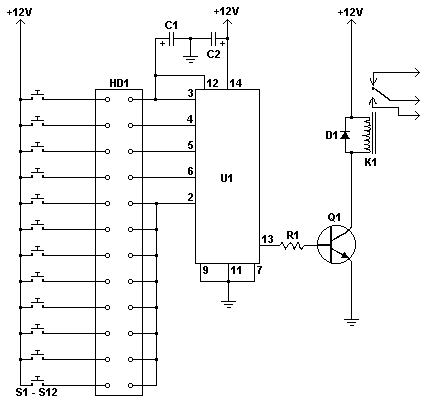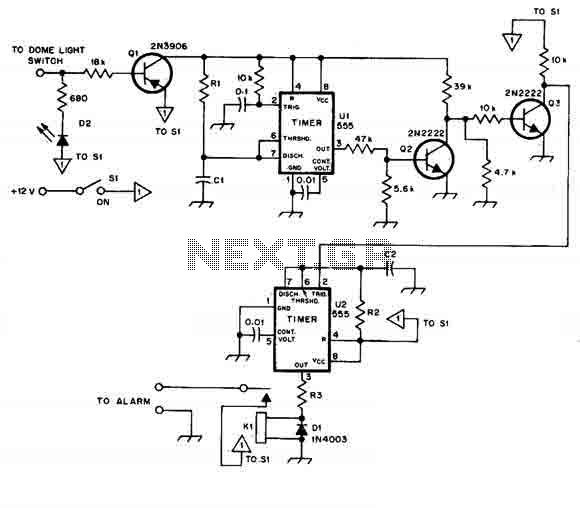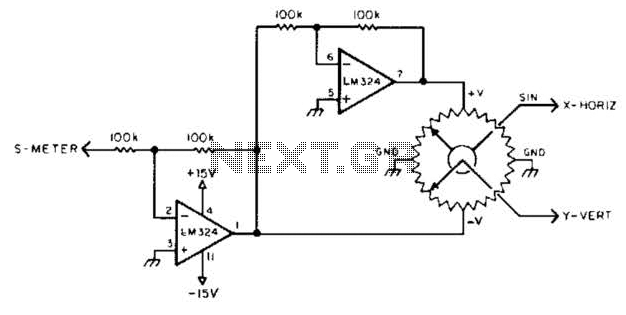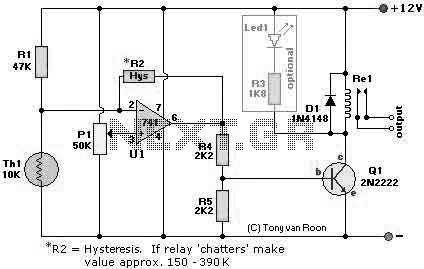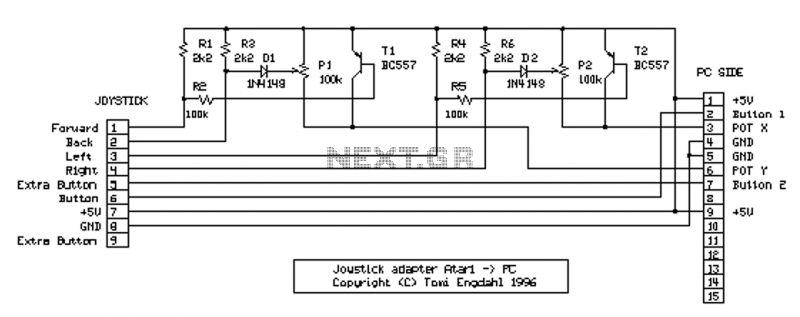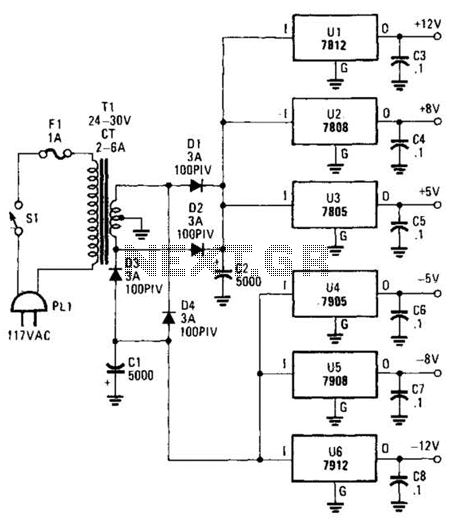
Automatic Level Control Signal Circuit
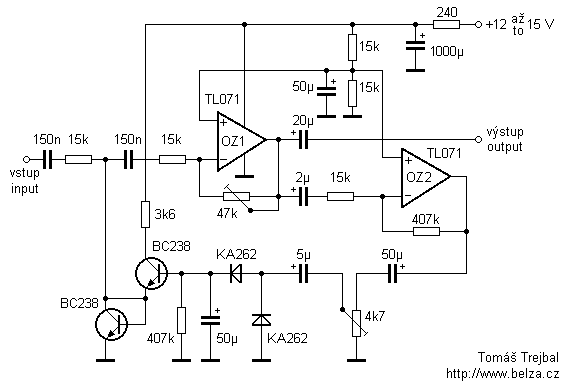
Involvement is a modified version of the classic circuit of automatic level control signal used in tape recorders. The purchase price of the components (using TL072) does not exceed CZK 60 for a channel. For a range of entry level audio signal may be replaced by the operation, which would be matched signal level so as not to overmodulation or podmodulován. The device performs a kind of correction pseudointeligentní volume. The circuit is also under the control settings and time constants trimmer member RC nabíjeného output signal through a silicon rectifier diodes and function of compressor frequency signal, which means that it reduces the dynamic range (the ratio of the loudest / quietest signal for a certain period of time). More: Connection is very useful for anyone who wants to easily record and process signals of different levels without having to painstakingly matched volume and feared overmodulation. The adjustment signal is suitable for listening in places where there is high noise level and is therefore unsuitable for a large dynamic range of listening, because the quiet passages are heard loud and they are too strong. These and similar problems that involvement in addressing the consequences. For demanding, then I recommend the use of this involvement in the three-band version. In this device, signals are processed separately deep, medium and high frequencies, and then in physiologically "friendly" relationship are mixed together again. The device operates in a very simplified form like Optimod - audio editing equipment used in radio adverts are aired before the signal "into the ether. This device provides full color saturation, and audio for any signal source, which provides pseudointeligentn? signal so that the optimal subjective and, above all clearly audible and understandable. Unlike the aforementioned device does not feature the involvement of the gate (ie, silencing of noise and interference signals in prázdých passages), it should be combined with the system to be DNR (DNL) or with a simple Quieting. Wiring is quite simple. As active elements can be used in virtually any silicon transistors and operational amplifiers. It is desirable that the first operational amplifier, which amplifies the input signal at the output was less noise. Therefore, combining low noise such as Mark and the second should be used TL071, TL072, or use a flat, which includes both Mark. Because the amplification circuit is not large, there is no need to use the Mark with extremely low noise. I was led to the input signal with an amplitude of 0.5 to 4 V, the output signal level was stable around 0.5 V.
The input signal comes through the decoupling capacitor 150 nF and 15 Ohm resistor to the point where zatlumován regulatory element - a transistor KC238 against the country. In this key part of the circuit follows the standard Mark involvement with unbalanced power, in which an artificial center of power created by two 15 Ohm resistors and filter capacitor 50 uF to ground. Profit Mark is set by trimmer 47 kOhm. The profit depends Mark range of input voltage that the circuit is able to "uregulovat. If you use the trimmer resistance 100 Ohm, you will be able to control the gain to a greater extent, be careful not to pull hum and noise in quiet passages. The OZ1 signal is maintained at the output, which should not be overly burdened. It also amplifies the signal and OZ2 to the level needed to guide the member's and charging RC , managerial control circuit with two transistors. To nezakmitávalo involvement and clipping is not too large, adjust the trimmer útltumový member. Set up by the output signal level and scope of regulation. The trimmer is usually set at about half to two thirds of the runway.
The values of the components used in the engagement are critical, you can use the closest value without noticeable changes in properties of Engagement. Important is only the carefully calibrated gain trimmer Mark, in the absence of Mark did not augment the signal noise and interference, the trimmer control levels for the detector, which sets the optimum mode without ringing.
This circuit functions as an automatic level control (ALC) system, suitable for audio applications where varying signal levels can lead to distortion or undesirable sound quality. The use of operational amplifiers, particularly the TL072, allows for low-noise amplification of audio signals. The inclusion of a decoupling capacitor at the input ensures that any DC offsets are removed, providing a cleaner signal for processing.
The core of the circuit is the feedback mechanism created by the operational amplifiers and the gain control trimmer. The gain can be adjusted to accommodate different input levels, ensuring that the output signal remains within a specified range, thus preventing overmodulation. The use of a silicon rectifier diode in the feedback loop aids in the compression of the signal, effectively reducing the dynamic range. This is particularly useful in environments with high ambient noise, where a broader dynamic range might cause quieter sounds to be lost amidst background noise.
The circuit is designed such that it can be easily integrated into existing audio processing systems. The three-band version mentioned allows for more refined control over different frequency ranges, which can be particularly beneficial in complex audio environments. The design is flexible, permitting the use of various silicon transistors and operational amplifiers, which can be selected based on specific application requirements.
The output stage of the circuit maintains the integrity of the audio signal while ensuring that the output does not exceed the desired amplitude. This is achieved through careful selection of component values and calibration of the gain trimmer. Proper calibration is essential to minimize noise and ensure that the output signal is clean and clear, free from artifacts that can occur during amplification.
In summary, this automatic level control circuit offers a practical solution for managing audio signals in varying environments, providing a means to achieve consistent sound quality without manual adjustments. The design's simplicity and adaptability make it suitable for a wide range of applications in audio processing.Involvement is a modified version of the classic circuit of automatic level control signal used in tape recorders. The purchase price of the components (using TL072) does not exceed CZK 60 for a channel. For a range of entry level audio signal may be replaced by the operation, which would be matched signal level so as not to overmodulation or podmodulován.
The device performs a kind of correction pseudointeligentní volume. The circuit is also under the control settings and time constants trimmer member RC nabíjeného output signal through a silicon rectifier diodes and function of compressor frequency signal, which means that it reduces the dynamic range (the ratio of the loudest / quietest signal for a certain period of time). Connection is very useful for anyone who wants to easily record and process signals of different levels without having to painstakingly matched volume and feared overmodulation. The adjustment signal is suitable for listening in places where there is high noise level and is therefore unsuitable for a large dynamic range of listening, because the quiet passages are heard loud and they are too strong.
These and similar problems that involvement in addressing the consequences. For demanding, then I recommend the use of this involvement in the three-band version. In this device, signals are processed separately deep, medium and high frequencies, and then in physiologically "friendly" relationship are mixed together again. The device operates in a very simplified form like Optimod - audio editing equipment used in radio adverts are aired before the signal "into the ether.
This device provides full color saturation, and audio for any signal source, which provides pseudointeligentn? signal so that the optimal subjective and, above all clearly audible and understandable. Unlike the aforementioned device does not feature the involvement of the gate (ie, silencing of noise and interference signals in prázdých passages), it should be combined with the system to be DNR (DNL) or with a simple Quieting.
Wiring is quite simple. As active elements can be used in virtually any silicon transistors and operational amplifiers. It is desirable that the first operational amplifier, which amplifies the input signal at the output was less noise. Therefore, combining low noise such as Mark and the second should be used TL071, TL072, or use a flat, which includes both Mark.
Because the amplification circuit is not large, there is no need to use the Mark with extremely low noise. I was led to the input signal with an amplitude of 0.5 to 4 V, the output signal level was stable around 0.5 V.
The input signal comes through the decoupling capacitor 150 nF and 15 Ohm resistor to the point where zatlumován regulatory element - a transistor KC238 against the country. In this key part of the circuit follows the standard Mark involvement with unbalanced power, in which an artificial center of power created by two 15 Ohm resistors and filter capacitor 50 uF to ground.
Profit Mark is set by trimmer 47 kOhm. The profit depends Mark range of input voltage that the circuit is able to "uregulovat. If you use the trimmer resistance 100 Ohm, you will be able to control the gain to a greater extent, be careful not to pull hum and noise in quiet passages. The OZ1 signal is maintained at the output, which should not be overly burdened. It also amplifies the signal and OZ2 to the level needed to guide the member's and charging RC , managerial control circuit with two transistors.
To nezakmitávalo involvement and clipping is not too large, adjust the trimmer útltumový member. Set up by the output signal level and scope of regulation. The trimmer is usually set at about half to two thirds of the runway. The values ??of the components used in the engagement are critical, you can use the closest value without noticeable changes in properties of Engagement. Important is only the carefully calibrated gain trimmer Mark, in the absence of Mark did not augment the signal noise and interference, the trimmer control levels for the detector, which sets the optimum mode without ringing.
🔗 External reference
The input signal comes through the decoupling capacitor 150 nF and 15 Ohm resistor to the point where zatlumován regulatory element - a transistor KC238 against the country. In this key part of the circuit follows the standard Mark involvement with unbalanced power, in which an artificial center of power created by two 15 Ohm resistors and filter capacitor 50 uF to ground. Profit Mark is set by trimmer 47 kOhm. The profit depends Mark range of input voltage that the circuit is able to "uregulovat. If you use the trimmer resistance 100 Ohm, you will be able to control the gain to a greater extent, be careful not to pull hum and noise in quiet passages. The OZ1 signal is maintained at the output, which should not be overly burdened. It also amplifies the signal and OZ2 to the level needed to guide the member's and charging RC , managerial control circuit with two transistors. To nezakmitávalo involvement and clipping is not too large, adjust the trimmer útltumový member. Set up by the output signal level and scope of regulation. The trimmer is usually set at about half to two thirds of the runway.
The values of the components used in the engagement are critical, you can use the closest value without noticeable changes in properties of Engagement. Important is only the carefully calibrated gain trimmer Mark, in the absence of Mark did not augment the signal noise and interference, the trimmer control levels for the detector, which sets the optimum mode without ringing.
This circuit functions as an automatic level control (ALC) system, suitable for audio applications where varying signal levels can lead to distortion or undesirable sound quality. The use of operational amplifiers, particularly the TL072, allows for low-noise amplification of audio signals. The inclusion of a decoupling capacitor at the input ensures that any DC offsets are removed, providing a cleaner signal for processing.
The core of the circuit is the feedback mechanism created by the operational amplifiers and the gain control trimmer. The gain can be adjusted to accommodate different input levels, ensuring that the output signal remains within a specified range, thus preventing overmodulation. The use of a silicon rectifier diode in the feedback loop aids in the compression of the signal, effectively reducing the dynamic range. This is particularly useful in environments with high ambient noise, where a broader dynamic range might cause quieter sounds to be lost amidst background noise.
The circuit is designed such that it can be easily integrated into existing audio processing systems. The three-band version mentioned allows for more refined control over different frequency ranges, which can be particularly beneficial in complex audio environments. The design is flexible, permitting the use of various silicon transistors and operational amplifiers, which can be selected based on specific application requirements.
The output stage of the circuit maintains the integrity of the audio signal while ensuring that the output does not exceed the desired amplitude. This is achieved through careful selection of component values and calibration of the gain trimmer. Proper calibration is essential to minimize noise and ensure that the output signal is clean and clear, free from artifacts that can occur during amplification.
In summary, this automatic level control circuit offers a practical solution for managing audio signals in varying environments, providing a means to achieve consistent sound quality without manual adjustments. The design's simplicity and adaptability make it suitable for a wide range of applications in audio processing.Involvement is a modified version of the classic circuit of automatic level control signal used in tape recorders. The purchase price of the components (using TL072) does not exceed CZK 60 for a channel. For a range of entry level audio signal may be replaced by the operation, which would be matched signal level so as not to overmodulation or podmodulován.
The device performs a kind of correction pseudointeligentní volume. The circuit is also under the control settings and time constants trimmer member RC nabíjeného output signal through a silicon rectifier diodes and function of compressor frequency signal, which means that it reduces the dynamic range (the ratio of the loudest / quietest signal for a certain period of time). Connection is very useful for anyone who wants to easily record and process signals of different levels without having to painstakingly matched volume and feared overmodulation. The adjustment signal is suitable for listening in places where there is high noise level and is therefore unsuitable for a large dynamic range of listening, because the quiet passages are heard loud and they are too strong.
These and similar problems that involvement in addressing the consequences. For demanding, then I recommend the use of this involvement in the three-band version. In this device, signals are processed separately deep, medium and high frequencies, and then in physiologically "friendly" relationship are mixed together again. The device operates in a very simplified form like Optimod - audio editing equipment used in radio adverts are aired before the signal "into the ether.
This device provides full color saturation, and audio for any signal source, which provides pseudointeligentn? signal so that the optimal subjective and, above all clearly audible and understandable. Unlike the aforementioned device does not feature the involvement of the gate (ie, silencing of noise and interference signals in prázdých passages), it should be combined with the system to be DNR (DNL) or with a simple Quieting.
Wiring is quite simple. As active elements can be used in virtually any silicon transistors and operational amplifiers. It is desirable that the first operational amplifier, which amplifies the input signal at the output was less noise. Therefore, combining low noise such as Mark and the second should be used TL071, TL072, or use a flat, which includes both Mark.
Because the amplification circuit is not large, there is no need to use the Mark with extremely low noise. I was led to the input signal with an amplitude of 0.5 to 4 V, the output signal level was stable around 0.5 V.
The input signal comes through the decoupling capacitor 150 nF and 15 Ohm resistor to the point where zatlumován regulatory element - a transistor KC238 against the country. In this key part of the circuit follows the standard Mark involvement with unbalanced power, in which an artificial center of power created by two 15 Ohm resistors and filter capacitor 50 uF to ground.
Profit Mark is set by trimmer 47 kOhm. The profit depends Mark range of input voltage that the circuit is able to "uregulovat. If you use the trimmer resistance 100 Ohm, you will be able to control the gain to a greater extent, be careful not to pull hum and noise in quiet passages. The OZ1 signal is maintained at the output, which should not be overly burdened. It also amplifies the signal and OZ2 to the level needed to guide the member's and charging RC , managerial control circuit with two transistors.
To nezakmitávalo involvement and clipping is not too large, adjust the trimmer útltumový member. Set up by the output signal level and scope of regulation. The trimmer is usually set at about half to two thirds of the runway. The values ??of the components used in the engagement are critical, you can use the closest value without noticeable changes in properties of Engagement. Important is only the carefully calibrated gain trimmer Mark, in the absence of Mark did not augment the signal noise and interference, the trimmer control levels for the detector, which sets the optimum mode without ringing.
🔗 External reference
Warning: include(partials/cookie-banner.php): Failed to open stream: Permission denied in /var/www/html/nextgr/view-circuit.php on line 713
Warning: include(): Failed opening 'partials/cookie-banner.php' for inclusion (include_path='.:/usr/share/php') in /var/www/html/nextgr/view-circuit.php on line 713
